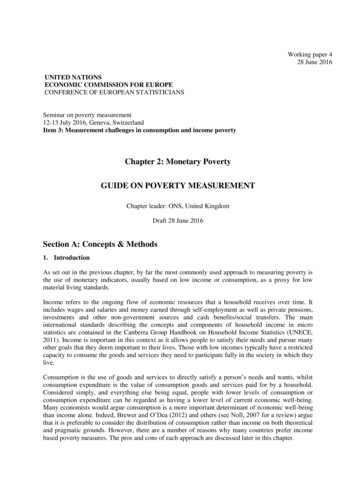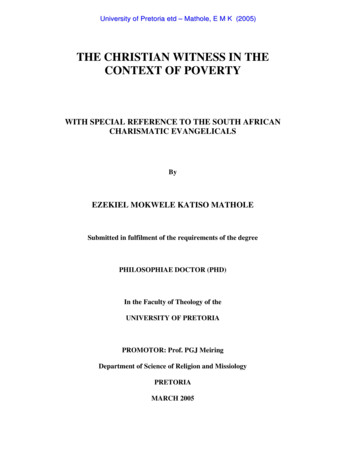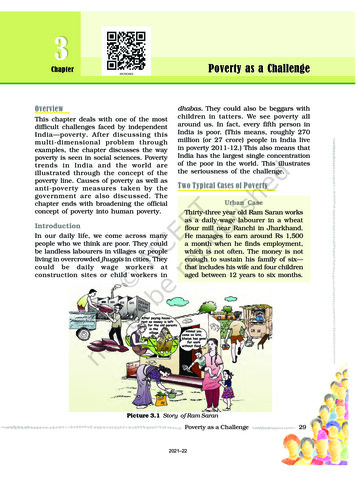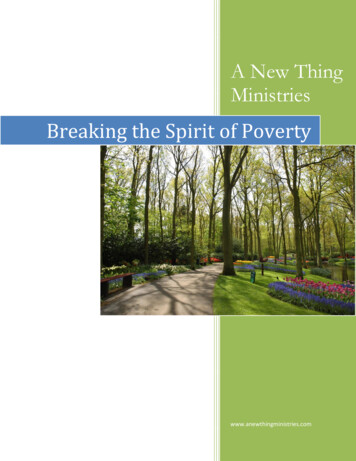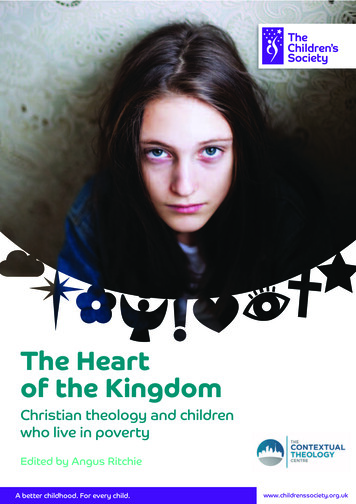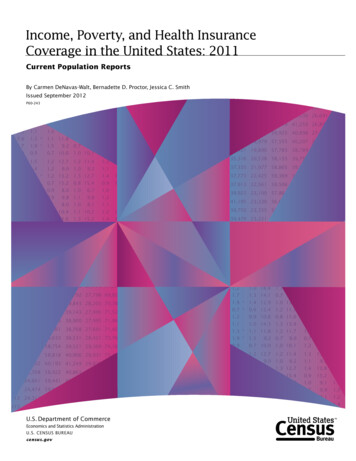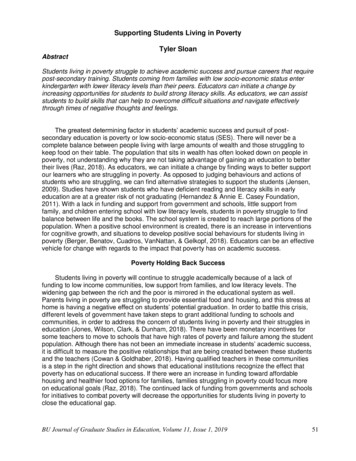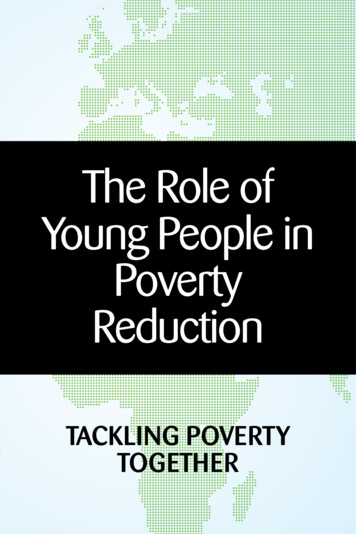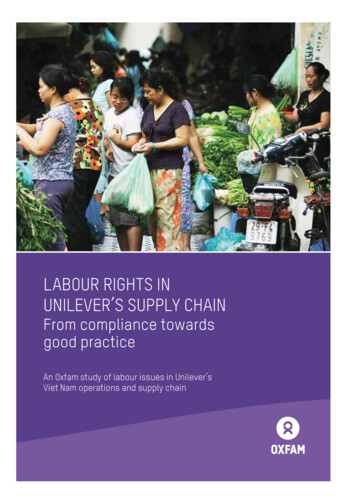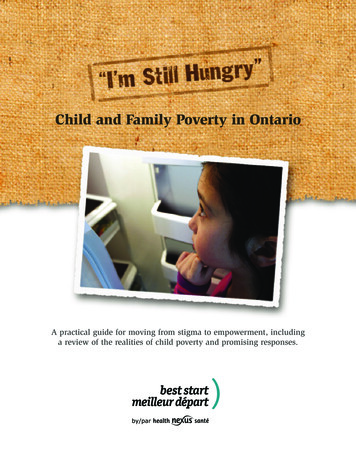
Transcription
Child and Family Poverty in OntarioA practical guide for moving from stigma to empowerment, includinga review of the realities of child poverty and promising responses.
AcknowledgementsPoverty is a broad issue with diverse andprofound impacts on families with youngchildren aged 0 to 6. Best Start Resource Centrewould like to thank Tekla Hendrickson forresearching and writing this resource, as wellas the parents, advisory members, and keyinformants for sharing their stories and expertise.Focus Group ParticipantsThank you to the families with young childrenwho took the time to participate in the focusgroups. Their wisdom and expertise wereinvaluable.Focus Group Organizers and Facilitators Algoma Public Health AWARE (Action on Women’s Addictions –Research & Education) Rebecca Doreen, Niwasa AboriginalEducation Programs Colin Hughes, Children Aid Society of Toronto Laura Kucenty, Shout Clinic Michele Lupa, East York East Toronto FamilyResources Organization Glenda McArthur, Reproductive HealthFamily Health Division, Public HealthServices Hamilton Hayley McKeever, Best Start, District ofTimiskaming Social Services AdministrationBoard Cindy Sue McCorrmack, Social Planningand Research Council of Hamilton Dianne Morelli, Baby’s Breath Teen Prenataland Parenting ProgramAdvisory Committee and Key Informants Wendy O’Connell-Smith, CarlingtonCommunity Health Centre Peggy Carter-Arrowsmith, HamiltonFamily Health Team Wanda Romaniec, Carlington CommunityHealth Centre Julie Maher, Ontario Women’s HealthNetwork/Young Parents No Fixed Address Lee Soda, Agincourt Community ServicesAssociation Deirdre Pike, Social Planning andResearch Council of Hamilton John Stapleton, Metcalf Innovation Fellow,Metcalf Foundation Wendy Reynolds, AWARE (Action on Women’sAddictions – Research and Education) Johanne Thompson, Baby’s Breath TeenPrenatal and Parenting Program, SudburyBetter Beginnings Better Futures Laurel Rothman, Family ServiceToronto/Campaign 2000 Kim Scott, Hands TheFamilyHelpNetwork.ca Lyn Smith, Renfrew County Child PovertyAction Network (CPAN) Natasha So, CAPC Project, Brighter Futuresfor Children of Young ParentsAdditional Key Informants Paula Carrie, Aisling Discoveries Childand Family Centre Richard De La Ronde, Sandy Bay Ojibway Childand Family Services (Manitoba) Roxana Zuleta, Jane/Finch Communityand Family CentreReviewers Jen Amos, AWARE (Action on Women’sAddictions – Research & Education) Brenda Miller, AWARE (Action on Women’sAddictions – Research & Education) Kim Tytler, Canadian Child Care FederationProject Lead Wendy Burgoyne, Best Start Resource Centre
Table of ContentsIntroduction . . . . . . . . . . . . . . . . . . . . . . . . 2Working with Families andYoung Children Living in Poverty . . . . . 2Purpose. . . . . . . . . . . . . . . . . . . . . . . . . . 3Development Process . . . . . . . . . . . . . . . . 3Using the Manual . . . . . . . . . . . . . . . . . . 5Reflecting on Practice:Voices of the Service Providers . . . . . . . . . 58Areas of Practice forPractice Improvement . . . . . . . . . . . . 58Areas of Practice that Work . . . . . . . . . . 61Looking at Systems and Services. . . . . . . . 68The Research . . . . . . . . . . . . . . . . . . . . . . . . 6Government Promises to Children . . . . . . 6Definition of Poverty . . . . . . . . . . . . . . . . 8Overview of Poverty Statistics . . . . . . . . . 10Pathways to Poverty . . . . . . . . . . . . . . . . 14Effects of Poverty on Familiesand Young Children . . . . . . . . . . . . . 16Reflections . . . . . . . . . . . . . . . . . . . . . . . 31Living in Poverty: Voices of Parentswith Young Children . . . . . . . . . . . . . . . . . 32Listening to Parents . . . . . . . . . . . . . . . . 32Challenges of Living in Poverty. . . . . . . . 33Services and Supports . . . . . . . . . . . . . . 44What Families Want in TheirService Providers . . . . . . . . . . . . . . . . 55Top 10 Tips for Service Providers . . . . . . 57Characteristics of High Quality Services . 68Barriers to Providing These Services . . . . 69Moving Forward. Reducing theRates and Impacts of Child Poverty . . . . . . 74Policy Recommendations . . . . . . . . . . . . 75Promising Practices . . . . . . . . . . . . . . . . 76Caring for Staff. . . . . . . . . . . . . . . . . . . . . . 84Concluding Remarks . . . . . . . . . . . . . . . . . 85Resources . . . . . . . . . . . . . . . . . . . . . . . . . . 86Glossary . . . . . . . . . . . . . . . . . . . . . . . . . . . 90References . . . . . . . . . . . . . . . . . . . . . . . . . 92DisclaimerThis document has been prepared with funds provided by the Government of Ontario. The information herein reflectsthe views of the authors and is not officially endorsed by the Government of Ontario. The resources and programs citedthroughout this guide are not necessarily endorsed by the Best Start Resource Centre or the Government of Ontario.While the participation of the advisory committee and key informants was critical to the development of this Best Startresource, final decisions about content were made by the Best Start Resource Centre.Use of this ResourceThe Best Start Resource Centre thanks you for your interest in, and support of, our work. Best Start permits others tocopy, distribute or reference the work for non-commercial purposes on condition that full credit is given. Because ourresources are designed to support local health promotion initiatives, we would appreciate knowing how this resourcehas supported, or been integrated into, your work (beststart@healthnexus.ca).CitationBest Start Resource Centre (2010). “I’m Still Hungry” Child and Family Poverty in Ontario. Toronto, Ontario, Canada: author.Child and Family Poverty in Ontario1
IntroductionWorking with Families and Young Children Livingin PovertyThis resource focuses on families living in poverty who have young children between the ages of0 and 6. These families and children face many challenges as a result of living in poverty andoften turn to service providers for support in the navigation of these challenges and needed services.In order to be effective in their work, it is important for service providers to: have a broad understanding of the issues facing families living in poverty; develop an ability to see the intersectionsbetween these challenges; and reflect on what this means for their practice. To provide relevant andeffective supports to families with young children living in poverty, service providers need to reviewexamples of effective practices on an ongoing basis.Working with families living in poverty is not easy. The needs are often complex and, at times,certain necessary services may be unavailable. This can be difficult for service providers who wantto make a difference in the lives of families. Service providers can have a profound positive impacton children’s healthy development, as well as improving family well-being. To be effective in theirroles, it is important that service providers care for themselves, as well as consider creative solutionsto the pressing problems of families living in poverty.2“I’m Still Hungry”
PurposeThis manual provides an overview of the rates of child poverty and of the impacts of poverty onfamilies with young children. In addition, it shares effective strategies to reduce the rate of childpoverty and the impacts of poverty for these families. The manual provides an opportunity toreflect on: What you know about families with young children living in poverty The range of services that you provide to families living in poverty The service provider practices that help or hinder families living in poverty Connections of the services to the broader systemic and policy issues Examples of effective strategies in programming and practice.Development ProcessThis resource was developed though a review of the research and discussions with front-lineservice providers and topic experts, as well as focus groups with families living in poverty. Bydrawing on these rich sources, multiple perspectives were considered and a comprehensiveresource was developed. There was a strong commonality and consistency in the key messagesand recommendations across the varied references. When families, service providers, topic expertsand the research are all providing similar information and messages, it gives a clear indicationof how the day-to-day lives of families living in poverty can be improved.The voices and stories of the families living in poverty and of the service providers were the mostimportant sources of information for this resource. Families with young children living in povertyare not homogenous: in fact, they are exceptionally diverse. The participants in the focus groupsreflected that diversity. The service providers involved in this report have experience working witha wide range of families who experience poverty. The focus groups with parents and key informantinterviews with the service providers reflected the geographic diversity of Ontario and perspectivescame from urban, rural, and remote experiences. There was strong consistency around responsesand experiences, regardless of geographical location or the population.Details of Focus GroupsBest Start Resource Centre worked with localcommunity agencies that had positive relationshipsand reputations within their communities toconduct the focus groups. In addition to beingwell-regarded, these organizations already hadestablished trust and rapport with families wholive in poverty, ensuring that the parents in thefocus groups were able to speak freely. Threefocus groups were conducted with parents livingin poverty who had young children. They tookplace in Algoma, Sharbot Lake, and Kingston.Child and Family Poverty in Ontario3
Thirty-four parents of young children living in poverty participated in the focus groups, includingfive men and 29 women. In one focus group, 41% of the participants were Aboriginal. In the othertwo focus groups, 22% of the participants were Aboriginal and 9% were ethno-racial participants.The participants varied in age, with both women and men under 20 years old, 20 to 29 years old,and over 30. Parents in the focus groups represented many aspects of poverty, including parentswho were working in low-paying jobs (sometimes two or three), parents who were receivingOntario Works (OW), and parents who were on the Ontario Disability Support Program (ODSP).Details of Key Informant InterviewsBest Start Resource Centre conducted 21 key informant phone interviews, each approximately45 minutes in length. The service providers were sent the interview questions in advance to allowtime to prepare and reflect upon their responses.The service providers interviewed were selected for their experience and expertise in working withfamilies living in poverty. Most of the service providers were front-line workers and managers witha few service providers working in policy, planning, and advocacy.Poverty impacts all areas of the lives of families and young children. As a result, they have extensivecontact with a variety of services. To reflect this, a wide range of sector representation was includedin the key informant interviews. The key informants worked in Aboriginal family services, childwelfare, community health centres, community services, early years, family health teams, housing,mental health, public health, social assistance, social planning and social services.The interviewees had perspectives on issues facing families receiving social assistance and othersubsidies, the working poor, families that had been living in poverty for generations, families livingin subsidized housing, those paying market rent, and those without housing. Slightly over one-halfof the service providers workedpredominantly with lone-parentfamilies headed by womenwho often had experiencedabuse and violence at somepoint in their lives. Otherservice providers had extensiveexperience working withindividuals from diversefamily structures. In addition,the service providers in the keyinformant interviews workedwith young parents, immigrants,and refugees. A few of thekey informants worked withAboriginal families, on- andoff-reserve.4“I’m Still Hungry”
Using the ManualThis resource was written with a wide range of serviceproviders in mind. It is intended to support front-lineservice providers and managers, including those who workat the community level to address the social determinantsof health and those who work directly with families withyoung children living in poverty. Service providers andmanagers may work in programs that are specificallyestablished to meet the needs of families with youngchildren living in poverty or in programs that havefamilies with young children living in poverty as partof their larger participant group.This manual can be used to support training for serviceproviders new to the field. For service providers withextensive experience, it is an opportunity to reviewtheir knowledge, ensure it is current, and to reflecton their practice – identifying areas for training andimprovement. In addition, this resource can be usedby a team to review and assess current services.The resource begins by outlining the statistics onchild poverty and the major implications for the livesof families with young children living in poverty.Throughout this chapter, questions are raised toencourage service providers to reflect on the influencethat these realities have on their practice and abilityto serve this population. The next three chapters highlight the voices of the parents and theservice providers who contributed to this resource – talking about their experiences, beliefs, needs,and interactions with the systems and the services. Putting this information together creates acomprehensive and consistent picture of how systems and services can operate for optimum impact.The final chapter presents examples of services that address many of the themes brought forwardby the parents and the service providers.A list of key resources is provided at the end of the manual, including brief descriptions and linksto programs, reports, networks, and initiatives of particular interest in reducing child poverty.A glossary defines many of the terms used in this resource.Child and Family Poverty in Ontario5
The ResearchThis chapter provides an overview of key factsand figures relevant to working with familieswith children between the ages of 0 and 6 whoare living in poverty. For the purpose of thisresource, the understanding is that child povertyis family poverty. “Children are poor becausetheir families are poor” (National Council ofWelfare, 2007). Talking about child povertyinvolves reviewing statistical information aboutfamilies with young children living in poverty.This chapter presents: Government promises to children Definition of poverty Overview of poverty statistics Pathways to poverty Effects of poverty on young childrenand their familiesGovernment Promises to ChildrenChild and family poverty does not occur in a policy or political vacuum. It is important to have anunderstanding of the governments’ perspectives on child and family poverty and of how individualprograms and services fit into the larger picture. Through public resolutions and the signing ofinternational conventions, the federal government clearly acknowledges that child poverty is an issue.In 1989, the Canadian House of Commons unanimously resolved to eliminate child poverty by theyear 2000 (Conference Board of Canada, 2009; Campaign 2000, 2009). Twenty years have passedand child poverty has not been eliminated. While the rate of child poverty has fluctuated over thecourse of 20 years, there has not been a significant, sustained reduction. Recent statistics (2007)indicate about 1 in 10 children live in poverty (Campaign 2000, 2009).On November 24th, 2009, the Canadian government marked the 20th anniversary of the unanimousresolution of the government to eliminate child poverty. The Canadian government acknowledgedits failure to do so, reaffirmed its commitment to address child poverty, and resolved to develop animmediate plan to eliminate poverty in Canada for all (Campaign 2000, 2009).At the same time as the unanimous resolution to eliminate child poverty, the Canadian governmentsigned the Convention on the Rights of the Child (1990). In May 2002, at a UN General AssemblySpecial Session on Children, Canada, along with other nations, adopted a declaration and plan ofaction called A World Fit for Children. In 2004, the Canadian government created A Canada Fit forChildren plan of action (Canadian Government, 2004).6“I’m Still Hungry”
Some important initiatives have been implemented including the Canada Child Tax Benefit andNational Child Benefit Supplement for low and modest income families. Yet Canada is still 25th outof 30 Organisation for Economic Co-operation and Development (OECD) countries in the percentageof gross domestic product (GDP) spent on social spending. This means that less money is spent onbenefits for families and the unemployed in Canada than in most other OECD countries (Campaign2000, 2009). The sustained rates of child poverty indicate that the right mix of labour marketsolutions, public policies, and approaches to service delivery have not yet been implemented.Program Example: Community Monitoring and AccountabilityOntario Campaign 2000 is a diverse, non-partisan network of more than 60 local and provincialgroups committed to raising awareness about child and family poverty, proposing practical solutions,and holding governments to their commitments on poverty reduction.Partners in the Ontario Campaign 2000 coalition work together to monitor and hold governmentaccountable through the annual release of the Ontario Report Card on Child and Family Poverty.This report provides the latest facts on child poverty and tracks progress (or lack of) on povertyreduction. The report is used to garner media coverage and as a lobbying tool in meetings withpoliticians from all parties.(Maund, 2009)As provinces adopt a more active role in poverty reduction, important progress is being made.Ontario is a good example. The Ontario government released the document, Breaking the Cycle:Poverty Reduction Strategy for Ontario in December 2008 (Ontario Ministry of Children and YouthServices, 2008). This long-term strategy sets outs goals, timelines and indicators for tracking progress.In April 2009, all parties in the legislature approved the Poverty Reduction Act which requires theProvince of Ontario to review and set new targets every five years. To learn more about the OntarioPoverty Strategy go to www.ontario.ca/growingstrongerOpportunity to Reflect and DiscussIn 1989, Canada resolved to eliminate child poverty in Canada by the year 2000. Yet the rates of childpoverty have barely decreased over two decades – why is that? What influences the rate of child poverty?What can you do in your practice to support services and policies that make a difference?Child and Family Poverty in Ontario7
Definition of PovertyCanada does not have an official measure of poverty but draws on several existing measures oflow income that are updated annually. Child poverty rates are reported differently dependingon the measure of poverty being used. Statistics Canada draws on its annual survey of incomes todefine an income cut-off at which people may be said to live in “straitened circumstances” withinsufficient money for basic needs. This is called the Low-Income Cut-Off (LICO) and is used bymost organizations including governments, non-governmental organizations, and academicinstitutions as the poverty line (Canadian Council on Social Development, 2008).Statistics Canada’s plain language definition of LICO is, “income levels at which families orpersons spend 20% more than the proportion of income that the average family spends of theirincome on food, shelter and clothing.” The LICO is adjusted for the population, the communityand the number of children in the family. For example, for a lone parent with one child in a largeurban area (500,000 ), the 2007 LICO after-tax is 21,851. This same family (lone parent andone child) in a rural area would be considered poor if their after tax income was below 14,295(Campaign 2000, 2009).Another established measure of low income is the Low Income Measure (LIM). Using the LIM, afamily is considered to live in poverty when their income is below 50% of median income, adjustedfor family size (Maund, 2009). TheLIM has been used by the Ontariogovernment to track child poverty,and is often used for internationalcomparison, as it is similar to whatthe European Community uses tomeasure poverty.The Ontario government has alsotracked poverty with the newlydeveloped Ontario Deprivation Index(ODI). The ODI, released in December2009, is a list of items or activitiesconsidered necessary for an adequatestandard of living. Those who arelow-income are unlikely to be ableto afford these items. The ODI isnot a comprehensive list of basicneeds, but is intended to distinguishbetween people who live in povertyand those who do not.8“I’m Still Hungry”
What items are included in the Ontario Deprivation Index? Do you eat fresh fruit and vegetables every day? Are you able to get dental care if needed? Do you eat meat, fish, or a vegetarian equivalent at least every other day? Are you able to replace or repair broken or damaged appliances such as a vacuum or a toaster? Do you have appropriate clothes for job interviews? Are you able to get around your community, either by having a car, by taking the bus, or using anequivalent mode of transportation? Are you able to have friends or family over for a meal at least once a month? Is your house or apartment free of pests, such as cockroaches? Are you able to buy some small gifts for family or friends at least once a year? Do you have a hobby or leisure 61 Q1 V1-eng.pdfRecent research talks about social exclusion and inclusion as the best ways of defining poverty(Kersetter, 2009). Poverty is not just about very low income but also about whether people canparticipate in a meaningful way in the society around them. Participants in the focus groupstalked about their feelings of social isolation and inability to be engaged in the community asa result of living in poverty.Opportunity to Reflect and Discuss Canada does not have an “official” definition of poverty. Low-Income Cut-Off (LICO) and Low IncomeMeasure (LIM) are the two measurements commonly used to determine the poverty line. What arethe challenges to eliminating poverty without an “official” definition? After reviewing the new Ontario Deprivation Index, which of the measurements captures your clients’experiences with poverty? How do you, your organization, and the clients that you serve define poverty?Child and Family Poverty in Ontario9
Overview of Poverty StatisticsThe Canadian and Ontario statistics provide a very general overview of poverty at the nationaland provincial levels. There are regional, municipal, and demographic differences within theOntario poverty rates. For example, Aboriginal children have higher than average child povertyrates. Detailed local statistics assist service providers in gaining an accurate picture of the localface of poverty.The most recent statistics on poverty are from 2007, when Ontario was experiencing strongeconomic growth. The statistics do not take into account the 2008 global economic downturnwhich had a significant impact on Canada, especially Ontario (Maund, 2009).CanadaIn 2007, about 1 in 10 or 637,000 children under 18 lived in poverty. This is the equivalent of a citywith the population of Mississauga.(National Council on Welfare, 2007)In 1989, about 790,000 children, or 12.9%, were living in poverty. This number did not decreasesubstantially despite the economic growth that began in 1998.(Maund, 2009)Families often move in and out of poverty. From 2002 to 2007, approximately 1.4 million Canadianchildren lived in poverty. The majority of the children lived in poverty for at least one year, while asmall number lived in poverty throughout this period.(National Council of Welfare, 2007)The rates of child poverty in North America are high compared to other developed countries.(The Canadian Council on Social Development, 2008)OntarioIn 2007, 11.7% of Ontario’s children lived in poverty based on Low Income Measure after Tax.Almost 6% of Ontario children lived far below the poverty line.(Maund, 2009)Opportunity to Reflect and Discuss What can be learned from the fact that child poverty rates decreased minimally during a period ofunprecedented economic growth? Statistics provide one aspect of the poverty story. What other factors do you need to consider whendeveloping a comprehensive picture of the experience of poverty in your community?10“I’m Still Hungry”
Poverty Rates are Higher in Certain PopulationsThe face of poverty is not homogenous. Some populations have a higher risk of poverty thanothers (Ontario Association of Food Banks, 2008B).In Ontario, the highest rates of poverty are seen among people with disabilities, Aboriginalpopulations, lone parents, and new Canadians (Maund, 2009; Provincial Working Group ofNipissing District, 2008; Ontario Association of Food Banks, 2008; Children’s Aid Society ofToronto, 2008). In addition, children living in remote communities and children in the childwelfare system are also more likely to experience poverty (Canadian Government, 2004).While children living in remote communities are more likely to live in poverty, the Greater TorontoArea (GTA) has the highest rate of child poverty in Ontario. Fifty per cent of children living inpoverty live in the Greater Toronto Area (Maund, 2009; Children’s Aid Society of Toronto, 2008).Family StatusMost low-income children live in two-parent familiesWhile there are higher rates of poverty in single-parent families, 54.2% of low-income children livein two-parent families.Lone parent families are at higher risk of living in povertyNearly 4 in 10 (38.6%) low-income children live in a family led by a female lone parent.(National Council on Welfare, 2007)Diverse Communities in OntarioRecent Immigrant FamiliesChildren in families who moved to Canada in the past five years experience the highest poverty rates.Almost one in every two recent immigrant children lives in poverty.Children with DisabilitiesMore than 1 in 4 (27%) children with disabilities live in low-income families.Children of Aboriginal IdentityAbout 1 in 3 (30%) children of Aboriginal identity live in a low-income family.(Maund, 2009)Opportunity to Reflect and Discuss The risk of poverty is not equal. Significant disparities exist based on gender, region, disability status,ethno-racial identity, length of time in Canada, and indigenous status. Given the above, how should this inform and impact your programs, service delivery and policies? When planning your services and programs how can you take into account the disparities in therisk of poverty?Child and Family Poverty in Ontario11
Low Wages, Social Assistance, and the Widening Gap“A job is not a guaranteed pathway out of poverty.”(Service Provider)“I have two jobs that are temporary, yet can’tprovide for my children.”(Parent living in poverty)The myth that most people who are poor are not working and are on welfare is not supported bythe statistics. Many families are juggling the challenge of raising children, working in precarious(not guaranteed or stable) employment, and have the additional burden of living in poverty.A lone mother explains the reality of living on a low-wage, “So many parents work long hours atlow-paying jobs just to make ends meet, but no matter how hard they work, or how many hoursthey put in, there is still not enough money to pay the rent AND feed the family at the end of themonth.” (Provincial Working Group of Nipissing District, 2008)Working full-time at minimum wage does not provide enough income to raise a family above thepoverty line. At no point during the past 10 years has a person working full-time earning minimum12“I’m Still Hungry”
wage been able to reach the LICO (Provincial Working Group of Nipissing District, 2008). Morethan one in three (34%) children living in poverty in Ontario lived in a family in which at leastone parent was working the equivalent of a full-time, full-year job (Maund, 2009). Even workingfull time, these parents were not able to lift their families out of poverty.This problem is compounded for women who continue to experience an income gap, earning70 cents for every dollar paid to men, while spending a disproportionate amount of time in unpaidwork related to child and elder care and other household responsibilities (Ontario Association ofFood Banks, 2008; Ontario Women’s Health Network, 2005).Opportunity to Reflect and DiscussThirty-four per cent of all children whose families are low-income, have at least one person is working.What are the implications for the services you provide? What does this indicate about the labour market?Social assistance benefit rates provide emergency incomes that are far below the poverty line.Families receiving social assistance, whether through Ontario Works or the Ontario DisabilitySupport Program, live below the poverty line. This means they are unable to meet their basic needsof food, shelter, and clothing.Lower income, as reflected in the rate of poverty, affects families and children in a variety of ways.In addition to looking at the rates of poverty, it is important to look at the gap between the richand poor which also has an adverse impact on families living in poverty. The gap between the richand poor in Canada has grown at a faster rate than in any other OECD country, except Germany, inthe last ten years (Campaign 2000, 2009; Canadian Policy Research Network, 2007). This is a clearindication that the benefits of
Working with Families and Young Children Living in Poverty This resource focuses on families living in poverty who have young children between the ages of 0 and 6. These families and children face many challenges as a result of living in poverty and often turn to service providers for sup
